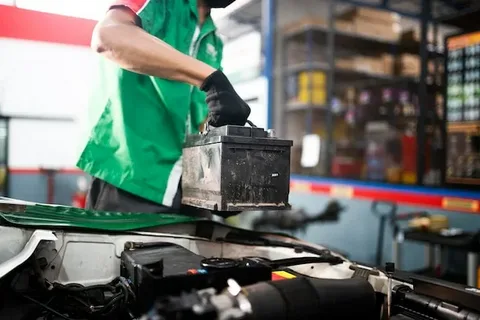How to Diagnose, Repair, or Replace a Hybrid Car Battery

As the global transition to sustainable transportation accelerates, hybrid vehicles have become increasingly popular for their fuel efficiency and environmental benefits. But like all automotive systems, hybrid batteries—an essential component of hybrid vehicles—are not immune to wear and tear. This guide provides an in-depth look into hybrid car battery repairs, helping you make informed decisions about diagnosis, repair, replacement, and maintenance.
What Is a Hybrid Battery?
Car hybrid battery repairs vehicles use a combination of a gasoline engine and one or more electric motors, powered by a high-voltage battery pack. Unlike traditional 12V batteries, hybrid batteries are designed to charge and discharge frequently to support both electric-only driving and assist during acceleration.
There are two main types of hybrid batteries:
- Nickel-Metal Hydride (NiMH) – Found in many older hybrid models like the Toyota Prius.
- Lithium-Ion (Li-ion) – More common in newer hybrids due to their lighter weight and better energy efficiency.
Signs Your Hybrid Battery Needs Repair
Just like regular car components, hybrid batteries show signs of wear before complete failure. Identifying these early signs can save you significant money and prevent unexpected breakdowns.
Common symptoms of a failing hybrid battery include:
- Decreased fuel efficiency – Your vehicle uses more gasoline than usual.
- Battery warning light – The dashboard shows a battery or check hybrid system warning.
- Reduced acceleration power – Performance drops, especially during climbs.
- Unusual engine behavior – The gasoline engine kicks in more frequently or unpredictably.
- Fluctuating state of charge (SOC) – Battery levels drop or rise rapidly.
If you notice any of these symptoms, it’s essential to have your hybrid system inspected by a qualified technician.
Causes of Hybrid Battery Failure
Understanding why hybrid batteries fail can help you avoid premature issues. Common causes include:
- Age and mileage – Most hybrid batteries last 8–10 years or 100,000–150,000 miles.
- Temperature extremes – Batteries degrade faster in very hot or cold climates.
- Poor maintenance – Ignoring cooling systems or using non-OEM parts can shorten battery life.
- Manufacturing defects – Some hybrid models have been prone to battery-related recalls.
Hybrid Battery Repair vs. Replacement
When your battery starts failing, you typically have three options: repair, recondition, or replace.
1. Battery Repair
Repair involves replacing damaged cells within the battery pack. It’s cost-effective but not always a long-term solution.
Pros:
- Cheaper than full replacement
- Quick fix
Cons:
- Not a permanent fix
- Risk of recurring issues with other cells
2. Battery Reconditioning
Reconditioning (also called refurbishing) includes balancing cell voltages and replacing faulty modules.
Pros:
- Extends life by 1–3 years
- More affordable than full replacement
Cons:
- Not suitable for heavily degraded batteries
- May require multiple attempts
3. Battery Replacement
Full replacement with a new or remanufactured battery.
Pros:
- Most reliable long-term solution
- Often backed by warranties (up to 3 years)
Cons:
- Most expensive option
How Much Does Hybrid Battery Repair Cost?
Costs vary based on make Car hybrid replacement, model, and repair type. Here’s a general breakdown (as of 2025 estimates):
| Repair Type | Estimated Cost (USD) |
|---|---|
| Cell/module repair | $500–$1,500 |
| Reconditioning | $1,200–$2,000 |
| New battery replacement | $2,000–$4,500 |
| Remanufactured battery | $1,500–$3,000 |
Tip: Always compare quotes from certified repair centers, and check if your battery is still under warranty.
Choosing the Right Repair Shop
Given the complexity of hybrid systems, it’s crucial to choose an experienced and certified technician. Here’s what to look for:
- Hybrid-certified specialists – Look for certifications like ASE L3 (Hybrid/Electric Vehicle).
- OEM tools and diagnostics – Ensure the shop uses manufacturer-recommended equipment.
- Transparent pricing and warranty – Ask for a detailed quote and warranty coverage.
You can use online reviews, forums, and local directories to find trustworthy hybrid repair shops near you.
Preventive Maintenance Tips to Prolong Battery Life
Maintaining your hybrid battery isn’t just about reacting to problems—it’s about preventing them. Here are expert-backed tips to increase battery longevity:
- Regular checkups – Have your battery and hybrid system inspected at least annually.
- Keep it cool – Ensure your battery cooling fan and vents are clean and unobstructed.
- Drive smart – Avoid excessive acceleration and braking, which stress the battery.
- Use hybrid-friendly mechanics – Not all auto shops understand hybrid systems.
- Avoid long periods of inactivity – Drive your vehicle regularly to maintain charge cycles.
Are Hybrid Batteries Covered Under Warranty?
Yes. Most hybrid vehicles come with an extended battery warranty. For example:
- Toyota – 10 years or 150,000 miles (whichever comes first)
- Honda – 8 years or 100,000 miles
- Ford – 8 years or 100,000 miles
Always check your manufacturer’s warranty details before opting for repairs.
Final Thoughts: Should You Repair or Replace?
The decision to repair or replace your hybrid battery depends on several factors—age of the vehicle, extent of damage, budget, and long-term plans. While repair and reconditioning are cost-effective short-term solutions, replacement is often more reliable for long-term peace of mind.
As hybrid technology evolves, repairs are becoming more accessible and affordable. By staying informed and proactive, you can extend the life of your vehicle and enjoy the eco-friendly benefits of hybrid driving for years to come.